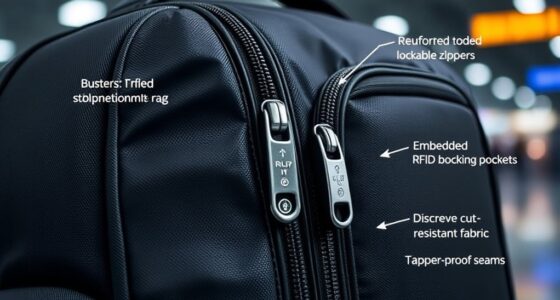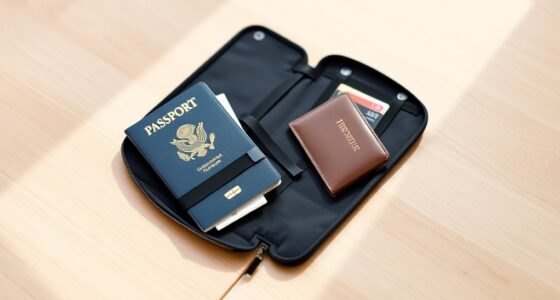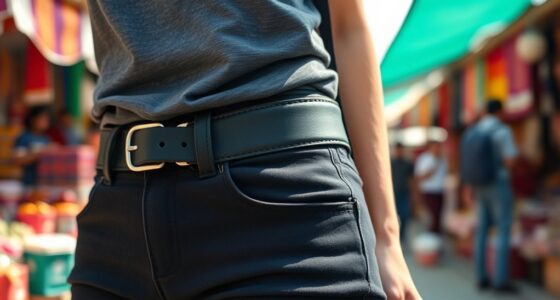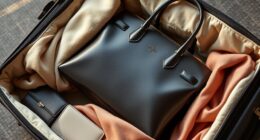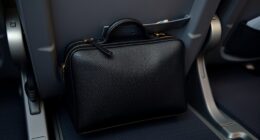When choosing a bag for backpacking and budget travel, you’ll want a size that balances capacity and portability—around 40 liters for short trips and larger if you’re carrying more gear. Prioritize comfort with adjustable straps, padded shoulder harnesses, and a supportive hip belt, ensuring proper fit helps prevent fatigue. Opt for lightweight, durable materials that withstand rough conditions. Focus on organization features to keep essentials accessible. Continue exploring for tips to find the perfect backpack that makes your journey easier and more enjoyable.
Key Takeaways
- Select a backpack with appropriate capacity (40-60 liters) to balance essentials and portability for budget travel.
- Prioritize lightweight, durable materials to reduce weight and withstand rough conditions.
- Ensure adjustable straps, padded harnesses, and a supportive hip belt for comfort during extended wear.
- Use multiple compartments and external pockets for efficient organization and easy access.
- Opt for a well-fitting pack that distributes weight evenly to prevent fatigue and improve mobility.
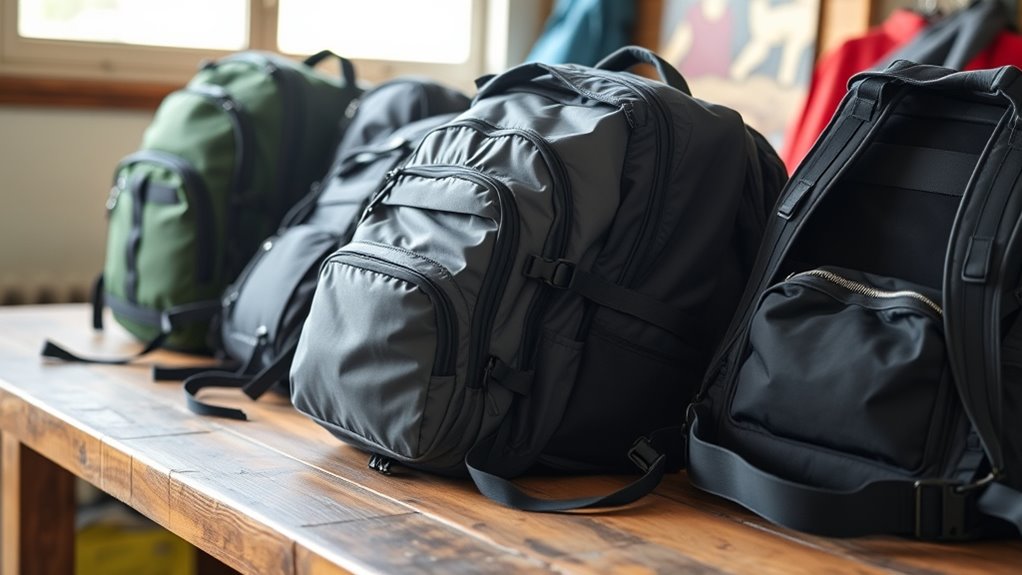
Are you overwhelmed by the options when choosing a bag for backpacking and budget travel? It’s a common feeling, especially with so many styles, sizes, and features to evaluate. The key is to focus on a bag that can carry your packing essentials comfortably while fitting your travel needs. When it comes to backpack sizing, think about how much space you truly need. If you’re planning short trips or weekend getaways, a smaller, 40-liter pack might be perfect. Longer adventures or those involving gear for outdoor activities may require a larger pack—up to 60 liters or more. The goal is to find a bag that balances capacity with portability; an overly large pack can become a burden, while a too-small one might leave you struggling to fit everything.
Start by gauging your packing essentials. List what you need to bring—clothes, toiletries, gadgets, and any specialized gear. This will help you determine the right size. For budget travel, lightweight and compact packing is usually best. You want a backpack that allows you to pack efficiently without excess bulk. Consider features like multiple compartments, compression straps, and external pockets that help organize your essentials and make packing and unpacking easier. Remember, the more organized your bag, the less you’ll have to carry around, and the more comfortable your trip will be.
Assess your packing essentials to choose a size that balances efficiency and comfort.
When choosing backpack sizing, it’s also important to think about your body frame and comfort. A pack that’s too big or heavy for your size can cause back pain and fatigue. Look for adjustable straps, padded shoulder harnesses, and a supportive hip belt—these help distribute weight evenly. Try on different backpacks with some weight inside to see how they feel. Your ideal backpack should sit comfortably on your back, with the weight evenly distributed and easy to carry through crowded streets or hiking trails. Additionally, selecting a high-quality, home-ready backpack with proper padding and support can significantly enhance your travel experience.
In addition to size and fit, consider the durability and weight of the backpack itself. A lightweight yet sturdy bag made from durable materials can save you from unnecessary strain and prevent damage during your travels. Budget-friendly options often include synthetic fabrics that are water-resistant and tough enough to handle rough conditions. Remember, your backpack is your home base on the road, so investing some time into selecting the right size and essentials will make your travels smoother and more enjoyable. Focus on packing essentials within a well-sized backpack, and you’ll be set for adventures that are both practical and fun.
Frequently Asked Questions
How Do I Determine the Right Bag Size for My Trip?
To determine the right bag size, consider your trip duration planning and pack size considerations. For short trips, a 40-50 liter pack usually suffices, while longer trips may require 60-70 liters. Think about the climate, activities, and personal packing style. If you’re packing light, go smaller; if you need more gear, choose a larger bag. Always prioritize comfort and accessibility for an enjoyable adventure.
What Materials Are Most Durable for Budget Backpacking Bags?
Like a trusty steed in a medieval quest, your backpack needs durable materials. Look for fabrics like ripstop nylon or polyester, as they excel in material durability and fabric longevity. These materials resist tears, abrasions, and water, making them perfect for budget backpacking adventures. By choosing bags with reinforced stitching and high-quality zippers, you guarantee your gear stays protected no matter where your journey takes you.
Are There Safety Features to Consider in a Travel Bag?
You should look for safety features like locking mechanisms and theft protection when choosing a travel bag. Locking zippers or combination locks help secure your belongings, while theft-resistant materials and hidden compartments add extra security. These features deter pickpockets and keep your valuables safe during your adventures. Prioritizing these safety elements guarantees peace of mind, so you can focus on enjoying your trip without worrying about potential theft.
How Do I Prevent My Bag From Becoming Too Heavy?
To prevent your bag from becoming too heavy, focus on proper weight distribution and packing techniques. Pack heavier items close to your back to balance the load, and use compression straps to secure your gear. Avoid overpacking by only bringing essentials, and utilize packing cubes to organize efficiently. Regularly reassess your pack’s weight as you go, removing unnecessary items to keep it manageable and comfortable for your journey.
Can I Use a Sports or Gym Bag for Backpacking?
Did you know that nearly 60% of backpackers prefer dedicated travel backpacks over sports or gym bags? You can use sports or gym bags for backpacking, but they may lack proper support and organization. Sports bags are usually lightweight and flexible, making them easy to carry, but they often don’t have padded straps or compartments. For comfort and durability, a backpack designed for travel is generally a better choice.
Conclusion
As you strap your chosen bag onto your shoulders, feel the sturdy fabric mold to your back, ready to carry your adventures. Imagine strolling through bustling markets, mountain trails, or quiet village streets, your bag brimming with essentials and stories yet to be told. With the right backpack, each step becomes easier and more exciting. Embrace the journey ahead, knowing your bag is your trusty companion, ready to hold your dreams and discoveries in every corner of the world.

